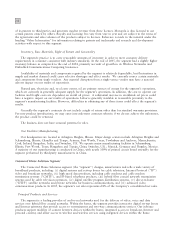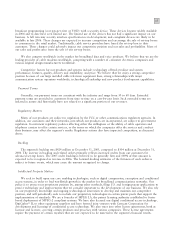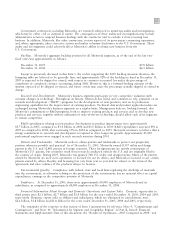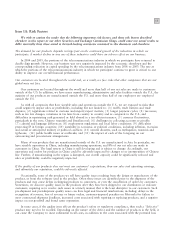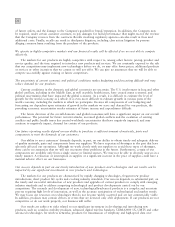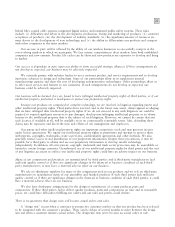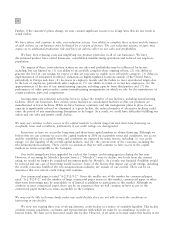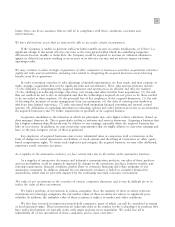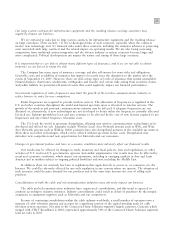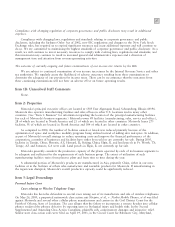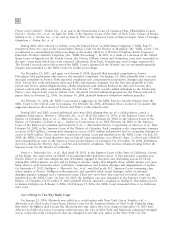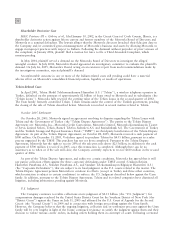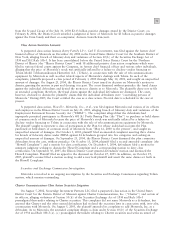Motorola 2005 Annual Report Download - page 29
Download and view the complete annual report
Please find page 29 of the 2005 Motorola annual report below. You can navigate through the pages in the report by either clicking on the pages listed below, or by using the keyword search tool below to find specific information within the annual report.
22
Further, if the customer's plans change, we may commit significant resources to design wins that do not result in
actual orders.
We have taken, and continue to take, cost-reduction actions. Our ability to complete these actions and the impact
of such actions on our business may be limited by a variety of factors. The cost reduction actions, in turn, may
expose us to additional production risk and have an adverse effect on our sales and profitability.
We have been reducing costs and simplifying our product portfolios in all of our businesses. We have
discontinued product lines, exited businesses, consolidated manufacturing operations and reduced our employee
population.
The impact of these cost-reduction actions on our sales and profitability may be influenced by factors
including, but not limited to: (1) our ability to successfully complete these ongoing efforts; (2) our ability to
generate the level of cost savings we expect or that are necessary to enable us to effectively compete; (3) delays in
implementation of anticipated workforce reductions in highly-regulated locations outside of the United States,
particularly in Europe and Asia; (4) decreases in employee morale and the failure to meet operational targets due
to the loss of employees, particularly sales employees; (5) our ability to retain or recruit key employees; (6) the
appropriateness of the size of our manufacturing capacity, including capacity from third parties; and (7) the
performance of other parties under contract manufacturing arrangements on which we rely for the manufacture of
certain products, parts and components.
An important cost-reduction action has been to reduce the number of our facilities, including manufacturing
facilities. All of our businesses have exited certain facilities or consolidated facilities so that our products are
manufactured in fewer facilities. While we have business continuity and risk management plans in place in case
capacity is significantly reduced or eliminated at a given facility, the reduced number of alternative facilities could
cause the period of any manufacturing disruptions to be longer. As a result, we could have difficulties fulfilling our
orders and our sales and profits could decline.
We may not continue to have access to the capital markets to obtain long-term and short-term financing on
acceptable terms and conditions, particularly if our credit ratings are downgraded.
From time to time we access the long-term and short-term capital markets to obtain financing. Although we
believe that we can continue to access the capital markets in 2006 on acceptable terms and conditions, our access
and the availability of acceptable terms and conditions are impacted by many factors, including: (i) our credit
ratings, (ii) the liquidity of the overall capital markets, and (iii) the current state of the economy, including the
telecommunications industry. There can be no assurances that we will continue to have access to the capital
markets on terms acceptable to the Company.
Our credit ratings have been upgraded by each of the 3 major credit rating agencies during the last year.
However, if our rating by Moody's Investor Service (""Moody's'') were to decline two levels from the current
rating, we would no longer be considered investment grade by Moody's. As a result, our financial flexibility would
be reduced and our cost of borrowing would increase. Some of the factors that impact our credit ratings, including
the overall economic health of the telecommunications industry, are outside of our control. There can be no
assurances that our current credit ratings will continue.
Our commercial paper is rated ""A-2/P-2/F-2.'' Given the smaller size of the market for commercial paper
rated ""A-2/P-2/F-2'' and the number of large commercial paper issuers in this market, commercial paper or other
short-term borrowings may be unavailable or of limited availability to participants in this market. Although we
continue to issue commercial paper, there can be no assurances that we will continue to have access to the
commercial paper markets on terms acceptable to the Company.
We may not be able to borrow funds under our credit facility if we are not able to meet the conditions to
borrowing in our facility.
We view our existing three-year revolving domestic credit facility as a source of available liquidity. This facility
contains various conditions, covenants and representations with which we must be in compliance in order to
borrow funds. We have never borrowed under this facility. However, if we wish to borrow under this facility in the


